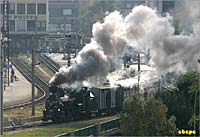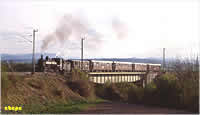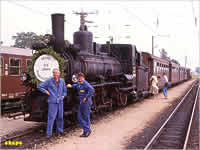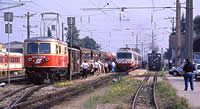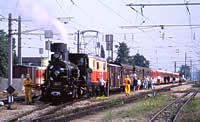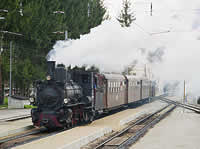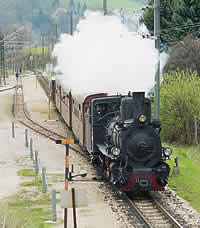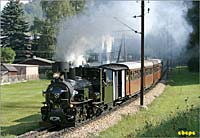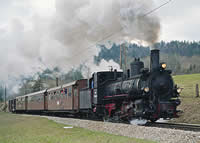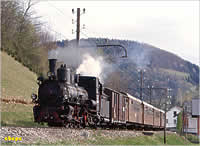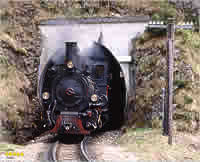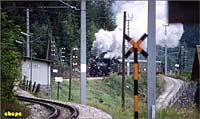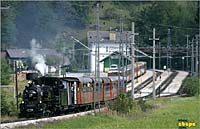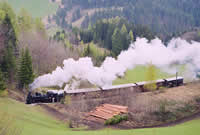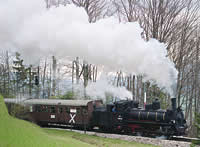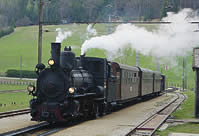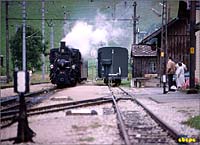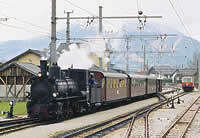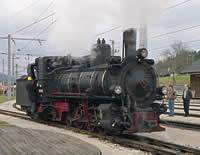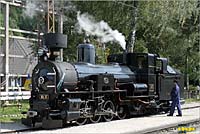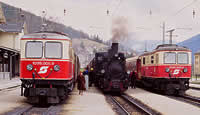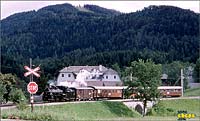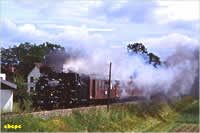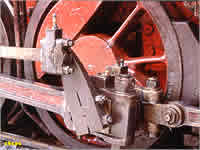| |
St.
Poelten main station. At platform 24 a special train headed by the
steam locomotive Mh.6 is ready for departure. September 7th is one
of about 13 regular steam operation days in 2003. The train runs
instead of 6859. Some Japanese camera team produced video shots
from this run.
|
|
| Click
on images to get enlarged presentation! |
|
|
|
| |
Taking
pictures of steam locomotives always includes potential surprise.
In advance one often don't know in which direction the trail of smoke
will move. Sometimes a good looking perspective may totally get disturbed
by smoke. Here this didn't happen and the steam exhaust lets view
open to the carriages (9/2003). |
|
|
|
|
| |
All
necessary shunting jobs in order to finally compose the mentioned
train were executed by the Mh.6 crew at the Alpenbahnhof area. (top
of page) |
|
|
|
|
| |
A
special train which was in operation in 1989 when the anniversary
"100 years narrow gauge railroads in Austria" was celebrated,
crosses the Pielach river on its way to Ober Grafendorf. |
|
|
|
|
| |
Here
a train runs on the straight line section, which follows up the Pielach
bridge in the background. Behind the loco, a generator car is clutched.
It is needed for power supply especially of the dining and bar carriage.
(9/2003) |
|
|
|
|
| |
A
day in August 1990. The 85 years anniversary of the line to Mank and
Ruprechtshofen is celebrated. Someone put special decoration on the
boiler door. Everything seems to be okay for machinist and stoker.
At Ober Grafendorf they friendly smile for the photographers ... (top
of page) |
|
|
|
|
| |
Three
different generations of Mariazell line vehicles meet at the Ober
Grafendorf station in summer 1996. Left the 1099.001 from 1911, then
a railcar 4090.003 from 1994 and finally at the right the Mh.6 from
1908. |
|
|
|
|
| |
After
departure of the 4090 driven regular train, this unusual composition
got clutched. The train consists of two parts. The 4 brown cars in
the front arrived with the Mh.6, the others with the 1099.001. Now
everything was clutched together (~13 cars) and Mh and 1099 worked
as tandem. |
|
|
|
|
| |
From
some hill behind the Ober Grafendorf area, a good line overview is
possible. Here the trail of smoke is not totally ideal for the photographer
(9/2003). (top of page) |
|
|
|
|
| |
In
1988 a special train hauled by 399.02 is on tour to Mariazell. As
indicated by the four station tracks, the Kirchbach station is passed.
All stations are equipped for train crossings from the rail track
layout. But just few are manned and really foreseen for crossings.
|
|
|
|
|
| |
The
same train at the Loich station which is next after Kirchberg. Due
to fine contrast conditions, details of the loco body are visible
clearly. A bit cloudy weather conditions may be positive for photo
results, because too high contrasts are prevented.
Especially
slide film is limited to a 5 stop range of aperture. Contrasts equivalent
more than 5 stops may not be reproduced correctly.
|
|
|
|
|


